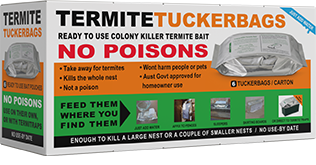Pine log house termites swarm
I just received an email describing a family’s midnight horror.
Termites decided to swarm inside a pine log house in a bushland setting.
Instead of launching into the night and fluttering away, the termite engineering committee got it wrong by 180 degrees and thousands upon thousands of ‘teenaged’ termites poured out of ceiling timbers into the house.
They just kept on coming until the rooms seemed to be so full of the erratically zooming termites the frightened kids were bundled up and it was the family that disappeared into the night towards a neighbour’s home.
They wanted to know what happened, what they should do next — and the neighbour was also concerned in case the termites flew in under the corrugated iron roof of their rammed earth walled house.
The phenomenon of swarming termites
The nests of the termites that do the most significant damage to buildings are usually below ground level but when it comes to colonising flight time, the reproductives launch themselves from one of the highest points in their colony workings.
This is because they are weak fliers; they cannot take off from a flat surface. Jumping out of damaged timber up high gives them a chance to flutter further before they hit the ground.
Launching on the inside means all of these termites would not be able to find a suitable nesting start-up site — they require food (timber) in moist soil.
Inside is dry and these ‘teenagers’ looking for a trysting place are unable to find one and they dry out and die unless ants get them first or they meet an earlier demise at the hands of fly spray.
There is an easy treatment now for that cabin: it won’t be difficult to find some timbers inside which termites are still busy gnawing away.

A small hole is pried into any hollowed timbers to ensure they are in there and then that hole is covered with a caché of termite bait using aluminium cooking foil and duct or gaffer tape.
The home page of our website has a video and description.
Now to defending the formed earth home
Swarming termites won’t find a constant source of moisture to set up the first royal chamber inside a roof.
The timber is there, but it is dry. Here’s what I suggested: Inspect all the inside timbers and mouldings. (click for Termite Inspection help)
Professional Pest Controllers
A lot of people bag ‘mud’ houses for providing a termite haven. Not me.
If, as yours is, the earth bricks are laid on a concrete slab it is hardly different from conventional construction on a concrete slab. You can see the edge of the slab to detect if termites are crossing from the soil to the walls and can notice and take appropriate action.
But because there are often access points near steps and doorways and the junction between patios and the building proper it pays to inspect at least twice a year and use TermiTraps as the first line of defence.



Hullo Kristine,
Spraying termiticide around means only the surface is treated and the termite action is usually 20mm or more below the surface. When a heavy application is applied against the foundation walls, the stumps or piers, the residue penetrates maybe 100-150mm (4-6inches). But this is done only to poison the soil adjacent to the foundations to stop termites coming through that soil to begin building a tunnel up into the house.
Spraying does not have any chance of killing a nest (unless you find the nest in a hollow tree, a stump or a mound)
About a month ago was the middle of the swarming season when the young reproductives go on their colonising flight. They could have flown out of a tree, a post, another building up to 200 metres away. 99+% of these never set up an established colony which is why we recommend spreading lots of our Termitetraps around so that one or two of them can intercept scouts from a nearby colony (that may have been established years ago) so they can be fed Bait in the Trap which they take back to kill off their colony wherever it is.
Hoping this explains the failure of the spraying. Ion Staunton